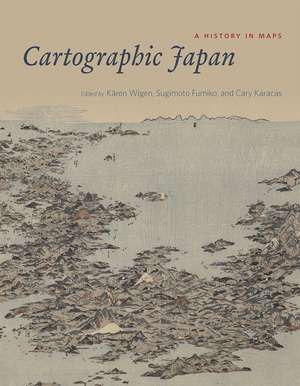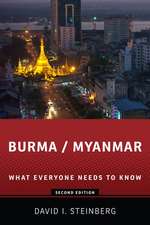Cartographic Japan: A History in Maps
Editat de Kären Wigen, Sugimoto Fumiko, Cary Karacasen Limba Engleză Hardback – 21 mar 2016
Miles of shelf space in contemporary Japanese bookstores and libraries are devoted to travel guides, walking maps, and topical atlases. Young Japanese children are taught how to properly map their classrooms and schoolgrounds. Elderly retirees pore over old castle plans and village cadasters. Pioneering surveyors are featured in popular television shows, and avid collectors covet exquisite scrolls depicting sea and land routes. Today, Japanese people are zealous producers and consumers of cartography, and maps are an integral part of daily life.
But this was not always the case: a thousand years ago, maps were solely a privilege of the ruling elite in Japan. Only in the past four hundred years has Japanese cartography truly taken off, and between the dawn of Japan’s cartographic explosion and today, the nation’s society and landscape have undergone major transformations. At every point, maps have documented those monumental changes. Cartographic Japan offers a rich introduction to the resulting treasure trove, with close analysis of one hundred maps from the late 1500s to the present day, each one treated as a distinctive window onto Japan’s tumultuous history.
Forty-seven distinguished contributors—hailing from Japan, North America, Europe, and Australia—uncover the meanings behind a key selection of these maps, situating them in historical context and explaining how they were made, read, and used at the time. With more than one hundred gorgeous full-color illustrations, Cartographic Japan offers an enlightening tour of Japan’s magnificent cartographic archive.
But this was not always the case: a thousand years ago, maps were solely a privilege of the ruling elite in Japan. Only in the past four hundred years has Japanese cartography truly taken off, and between the dawn of Japan’s cartographic explosion and today, the nation’s society and landscape have undergone major transformations. At every point, maps have documented those monumental changes. Cartographic Japan offers a rich introduction to the resulting treasure trove, with close analysis of one hundred maps from the late 1500s to the present day, each one treated as a distinctive window onto Japan’s tumultuous history.
Forty-seven distinguished contributors—hailing from Japan, North America, Europe, and Australia—uncover the meanings behind a key selection of these maps, situating them in historical context and explaining how they were made, read, and used at the time. With more than one hundred gorgeous full-color illustrations, Cartographic Japan offers an enlightening tour of Japan’s magnificent cartographic archive.
Preț: 314.48 lei
Nou
Puncte Express: 472
Preț estimativ în valută:
60.18€ • 62.60$ • 49.68£
60.18€ • 62.60$ • 49.68£
Carte disponibilă
Livrare economică 24 martie-07 aprilie
Livrare express 08-14 martie pentru 70.100 lei
Preluare comenzi: 021 569.72.76
Specificații
ISBN-13: 9780226073057
ISBN-10: 022607305X
Pagini: 336
Ilustrații: 111 color plates, 1 table
Dimensiuni: 216 x 279 x 25 mm
Greutate: 1.45 kg
Ediția:1
Editura: University of Chicago Press
Colecția University of Chicago Press
ISBN-10: 022607305X
Pagini: 336
Ilustrații: 111 color plates, 1 table
Dimensiuni: 216 x 279 x 25 mm
Greutate: 1.45 kg
Ediția:1
Editura: University of Chicago Press
Colecția University of Chicago Press
Notă biografică
Kären Wigen is the Frances and Charles Field Professor of history at Stanford University. Sugimoto Fumiko is professor of history at the University of Tokyo’s Historiographical Institute. Cary Karacas is associate professor of geography at the College of Staten Island, CUNY.
Cuprins
A Note on Japanese Names and Terms
Introduction
Kären Wigen
I. Visualizing the Realm: Sixteenth to Eighteenth Centuries
Introduction to Part I
Sugimoto Fumiko
Japan in the World
1. Japan in a New-Found World
Joseph Loh
2. The World from the Waterline
Peter D. Shapinsky
3. Elusive Islands of Silver: Japan in the Early European Geographic Imagination
Oka Mihoko
4. Mapping the Margins of Japan
Ronald P. Toby
5. The Creators and Historical Context of the Oldest Maps of the Ryukyu Kingdom
Watanabe Miki
6. The Introduction of Dutch Surveying Instruments in Japan
Satoh Ken’ichi
7. The European Career of Ishikawa Ryusen’s Map of Japan
Marcia Yonemoto
8. A New Map of Japan and Its Acceptance in Europe
Matsui Yoko
Domestic Space
9. The Arms and Legs of the Realm
Constantine N. Vaporis
10. Visualizing the Political World through Provincial Maps
Sugimoto Fumiko
11. Fixing Sacred Borders: Villagers, Monks, and Their Two Sovereign Masters
Sugimoto Fumiko
12. Self-Portrait of a Village
Komeie Taisaku
II. Mapping for the Market
Introduction to Part II
Kären Wigen
Mapping the City
13. Characteristics of Premodern Urban Space
Tamai Tetsuo
14. Evolving Cartography of an Ancient Capital
Uesugi Kazuhiro
15. Historical Landscapes of Osaka
Uesugi Kazuhiro
16. The Urban Landscape of Early Edo in an East Asian Context
Tamai Tetsuo
17. Spatial Visions of Status
Ronald P. Toby
18. The Social Landscape of Edo
Paul Waley
19. What Is a Street?
Mary Elizabeth Berry
Sacred Sites and Cosmic Visions
20. Locating Japan in a Buddhist World
D. Max Moerman
21. Picturing Maps: The “Rare and Wondrous” Bird’s-Eye Views of Kuwagata Keisai
Henry D. Smith II
22. An Artist’s Rendering of the Divine Mount Fuji
Miyazaki Fumiko
23. Rock of Ages: Traces of the Gods in Akita
Anne Walthall
24. Cosmology and Science in Japan’s Last Buddhist World Map
Sayoko Sakakibara
Travelscapes
25. Fun with Moral Mapping in the Mid-Nineteenth Century
Robert Goree
26. A Travel Map Adjusted to Urgent Circumstances
Kären Wigen and Sayoko Sakakibara
27. Legendary Landscape at the Kitayama Palace
Nicolas Fiévé
28. New Routes through Old Japan
Roderick Wilson
III. Modern Maps for Imperial Japan
Introduction to Part III
Cary Karacas
Defining the Borders
29. Seeking Accuracy: The First Modern Survey of Japan’s Coast
Suzuki Junko
30. No Foreigners Allowed: The Shogunate’s Hydrographic Chart of the “Holy” Ise Bay
Suzuki Junko
31. Indigenous Knowledge in the Mapping of the Northern Frontier Regions
Tessa Morris-Suzuki
32. Mamiya Rinzo and the Cartography of Empire
Brett L. Walker
33. Outcastes and Peasants on the Edge of Modernity
Daniel Botsman
Transforming the Cityscape
34. Converging Lines: Yamakawa Kenjiro’s Fire Map of Tokyo
Steven Wills
35. Mapping Death and Destruction in 1923
J. Charles Schencking
36. Rebuilding Tokyo after the Great Kanto Earthquake
André Sorensen
37. Shinjuku 1931: A New Type of Urban Space
Henry D. Smith II
Managing an Empire
38. Mapping the Hojo Colliery Explosion of 1914
Brett L. Walker
39. Cultivating Progress in Colonial Taiwan
Philip C. Brown
40. Showcase Thoroughfares, Wretched Alleys: The Uneven Development of Colonial Seoul (Keijo)
Todd A. Henry
41. Imperial Expansion and City Planning: Visions for Datong in the 1930s
Carola Hein
42. A Two-Timing Map
Catherine L. Phipps
43. Visions of a New Order in the Asia-Pacific
David Fedman
IV. Still under Construction: Cartography and Technology since 1945
Introduction to Part IV
Kären Wigen
Up from the Ashes
44. Blackened Cities, Blackened Maps
Cary Karacas and David Fedman
45. The Occupied City
Cary Karacas
46. Sacred Space on Postwar Fuji
Andrew Bernstein
47. Tange Kenzo's Proposal for Rebuilding Hiroshima
Carola Hein
48. Visions of the Good City in the Rapid Growth Period
André Sorensen
Growing Pains in a Global Metropolis
49. On the Road in Olympic-Era Tokyo
Bruce Suttmeier
50. Traversing Tokyo by Subway
Alisa Freedman
51. The Uses of a Free Paper Map in the Internet Age
Susan Paige Taylor
52. Tsukiji at the End of an Era
Theodore C. Bestor
New Directions in the Digital Age
53. Probabilistic Earthquake Hazard Maps
Gregory Smits
54. Citizens’ Radiation Maps after the Tsunami
Jilly Traganou
55. Run and Escape!
Satoh Ken’ichi
56. Postmortem Cartography: “Stillbirths” and the Meiji State
Fabian Drixler
57. Reconstructing Provincial Maps
Nakamura Yusuke
58. The Art of Making Oversize Graphic Maps
Arai Kei
Epilogue
Sugimoto Fumiko
Acknowledgments
About the Authors
Index
Introduction
Kären Wigen
I. Visualizing the Realm: Sixteenth to Eighteenth Centuries
Introduction to Part I
Sugimoto Fumiko
Japan in the World
1. Japan in a New-Found World
Joseph Loh
2. The World from the Waterline
Peter D. Shapinsky
3. Elusive Islands of Silver: Japan in the Early European Geographic Imagination
Oka Mihoko
4. Mapping the Margins of Japan
Ronald P. Toby
5. The Creators and Historical Context of the Oldest Maps of the Ryukyu Kingdom
Watanabe Miki
6. The Introduction of Dutch Surveying Instruments in Japan
Satoh Ken’ichi
7. The European Career of Ishikawa Ryusen’s Map of Japan
Marcia Yonemoto
8. A New Map of Japan and Its Acceptance in Europe
Matsui Yoko
Domestic Space
9. The Arms and Legs of the Realm
Constantine N. Vaporis
10. Visualizing the Political World through Provincial Maps
Sugimoto Fumiko
11. Fixing Sacred Borders: Villagers, Monks, and Their Two Sovereign Masters
Sugimoto Fumiko
12. Self-Portrait of a Village
Komeie Taisaku
II. Mapping for the Market
Introduction to Part II
Kären Wigen
Mapping the City
13. Characteristics of Premodern Urban Space
Tamai Tetsuo
14. Evolving Cartography of an Ancient Capital
Uesugi Kazuhiro
15. Historical Landscapes of Osaka
Uesugi Kazuhiro
16. The Urban Landscape of Early Edo in an East Asian Context
Tamai Tetsuo
17. Spatial Visions of Status
Ronald P. Toby
18. The Social Landscape of Edo
Paul Waley
19. What Is a Street?
Mary Elizabeth Berry
Sacred Sites and Cosmic Visions
20. Locating Japan in a Buddhist World
D. Max Moerman
21. Picturing Maps: The “Rare and Wondrous” Bird’s-Eye Views of Kuwagata Keisai
Henry D. Smith II
22. An Artist’s Rendering of the Divine Mount Fuji
Miyazaki Fumiko
23. Rock of Ages: Traces of the Gods in Akita
Anne Walthall
24. Cosmology and Science in Japan’s Last Buddhist World Map
Sayoko Sakakibara
Travelscapes
25. Fun with Moral Mapping in the Mid-Nineteenth Century
Robert Goree
26. A Travel Map Adjusted to Urgent Circumstances
Kären Wigen and Sayoko Sakakibara
27. Legendary Landscape at the Kitayama Palace
Nicolas Fiévé
28. New Routes through Old Japan
Roderick Wilson
III. Modern Maps for Imperial Japan
Introduction to Part III
Cary Karacas
Defining the Borders
29. Seeking Accuracy: The First Modern Survey of Japan’s Coast
Suzuki Junko
30. No Foreigners Allowed: The Shogunate’s Hydrographic Chart of the “Holy” Ise Bay
Suzuki Junko
31. Indigenous Knowledge in the Mapping of the Northern Frontier Regions
Tessa Morris-Suzuki
32. Mamiya Rinzo and the Cartography of Empire
Brett L. Walker
33. Outcastes and Peasants on the Edge of Modernity
Daniel Botsman
Transforming the Cityscape
34. Converging Lines: Yamakawa Kenjiro’s Fire Map of Tokyo
Steven Wills
35. Mapping Death and Destruction in 1923
J. Charles Schencking
36. Rebuilding Tokyo after the Great Kanto Earthquake
André Sorensen
37. Shinjuku 1931: A New Type of Urban Space
Henry D. Smith II
Managing an Empire
38. Mapping the Hojo Colliery Explosion of 1914
Brett L. Walker
39. Cultivating Progress in Colonial Taiwan
Philip C. Brown
40. Showcase Thoroughfares, Wretched Alleys: The Uneven Development of Colonial Seoul (Keijo)
Todd A. Henry
41. Imperial Expansion and City Planning: Visions for Datong in the 1930s
Carola Hein
42. A Two-Timing Map
Catherine L. Phipps
43. Visions of a New Order in the Asia-Pacific
David Fedman
IV. Still under Construction: Cartography and Technology since 1945
Introduction to Part IV
Kären Wigen
Up from the Ashes
44. Blackened Cities, Blackened Maps
Cary Karacas and David Fedman
45. The Occupied City
Cary Karacas
46. Sacred Space on Postwar Fuji
Andrew Bernstein
47. Tange Kenzo's Proposal for Rebuilding Hiroshima
Carola Hein
48. Visions of the Good City in the Rapid Growth Period
André Sorensen
Growing Pains in a Global Metropolis
49. On the Road in Olympic-Era Tokyo
Bruce Suttmeier
50. Traversing Tokyo by Subway
Alisa Freedman
51. The Uses of a Free Paper Map in the Internet Age
Susan Paige Taylor
52. Tsukiji at the End of an Era
Theodore C. Bestor
New Directions in the Digital Age
53. Probabilistic Earthquake Hazard Maps
Gregory Smits
54. Citizens’ Radiation Maps after the Tsunami
Jilly Traganou
55. Run and Escape!
Satoh Ken’ichi
56. Postmortem Cartography: “Stillbirths” and the Meiji State
Fabian Drixler
57. Reconstructing Provincial Maps
Nakamura Yusuke
58. The Art of Making Oversize Graphic Maps
Arai Kei
Epilogue
Sugimoto Fumiko
Acknowledgments
About the Authors
Index
Recenzii
"Cartographic Japan constitutes a significant addition to the academic literature on the history of Japanese mapping. Much like the works it describes, the volume may also be treasured as a piece of art and collector’s item in its own right. In appearance it is similar to an atlas: oversized, with slick heavy pages laden with full-color reproductions of historical maps....Inspired by the equally beautiful and sweeping Mapping Latin America: A Cartographic Reader (University of Chicago Press, 2011), Cartographic Japan is a deeply rewarding compilation of maps and the scholars who appreciate them. The result will be enjoyed not just by researchers in the field of Japanese studies but by all map lovers and bibliophiles."
"Written for a general audience, this remarkable volume is intended to introduce readers to the 'treasure trove of colorful materials' that make up 'one of the world’s most diverse and spectacular cartographic archives.' Each of the 58 short chapters focuses on a particular image—a tourist map of Edo, a Buddhist conception of global geography, a coastal survey, an outline of the destruction of Hiroshima, a digital rendering of radiation from the 3/11 nuclear disaster—accompanied by a few pages of descriptive text highlighting the map’s historical (or possibly social, political, cultural, or religious) context. Scholars of Japan will recognize a veritable who’s who of contributors, among them Ronald Toby, Marcia Yonemoto, Constantine Vaporis, Kären Wigen, Mary Elizabeth Berry, Henry D. Smith II, Tessa Morris-Suzuki, and Theodore Bestor. Given rising scholarly interest in material and popular culture, as well as Japan’s centuries-old mapmaking tradition, this is an endeavor both timely and timeless. Moreover, it is a beautiful book, with color photographs throughout. An enchanting and even poignant volume that should find a ready home in any college or university library. Essential."
"This capacious and thoughtful volume is simultaneously three books. It is an illustrated collection of essays on Japanese cartography for a broad audience; it is a skilfully curated cartographic trove dating from the late sixteenth century to the present day; last but not least, it offers a unique template for teaching the history of Japan through maps, both in the context of East Asia and within larger world history."
“A treasure trove of short essays on the history of mapping, Cartographic Japan offers a rich range of insights in the mapping of Japanese history across a remarkable range of scales. Among them are neighborhoods, markets, workplaces, cities, regions, colonies and empire, cosmology and religion, and of course various apprehensions of the nation-state. This book belongs on the shelf of anyone who teaches about Japan or who is fascinated by its history, as well as all those fascinated by the search for meaning in maps.”
“Cartographic Japan revels in how deeply maps have been embedded in organizing Japanese society and its literal and figurative boundaries, shaping knowledge and policies, and even saving lives, for the past fifteen hundred years. Whether carefully describing original mapmaking traditions or explaining why historical maps reprinted in the 1960s unleashed controversy, the fifty-eight short chapters and accompanying illustrations bring Japanese history to life in stories spanning space and time. The authors of this important and ambitious contribution offer scholars, students, and map buffs alike a privileged seat at the banquet table of cartographic history, with access to the plans, hopes, and dreams of an impressive range of Japanese leaders, intellectuals, merchants, and citizens and a handful of the foreigners who made maps matter.”
“If a picture paints a thousand words, this book shows how maps tell countless stories of Japan’s past. Not only do the fifty-eight short essays and multitude of illustrations in Cartographic Japan offer windows into particular moments in Japan’s history, but they also form fascinating visualized narratives. It is an innovative and enjoyable approach to imagining Japan’s past beyond simply the pragmatic function of these maps.”
"Cartographic Japan is a visually stunning and historically detailed compilation that illustrates this inherent power in maps and mapping while telling the story of one country’s history and place in the world."
"Cartographic Japan: A History in Maps, from the University of Chicago Press, is expressly intended to open a window for the non-Japanese reader on a sweeping landscape of Japanese cartographic artifacts, history, and scholarship."
"If you’ve ever wondered why Japanese cities have no street names, or why many modern tourist maps are cartoonish with no scale or positional accuracy, the book’s discussions of the roots of such phenomena should be of interest. . . .Cartographic Japan is thus an exploration to be welcomed—primarily for its informative and enriching text and additionally for the artistry contained in the maps it presents and the individual histories of these snapshots in time."
"The book is neither a history of maps nor a history of Japan, but rather an exercise in what it means to think about Japanese history with maps, a rewarding experience that made this reader realize that teaching or writing about Japan without regular reference to historic maps is no longer an option."













